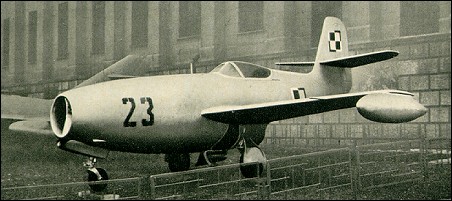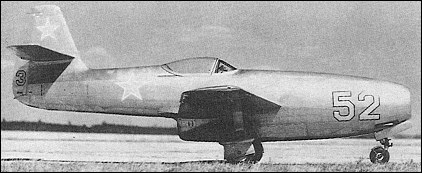 |
Yakovlev Yak-231948 |  |
| FIGHTER | Virtual Aircraft Museum / USSR / Russia / Yakovlev |
 |
Reverting to the so-called redan (stepped) configuration of the first Yakovlev jet fighters, the Yak-23 possessed wing and horizontal tail surfaces similar to those of the Yak-19, and was intended to fulfil a requirement for a lightweight day interceptor capable of operating from existing fields. The first of three prototypes of the Yak-23, which were of all-metal stressed-skin construction and powered by imported Rolls-Royce Derwent turbojets, was flown on 17 June 1947. Seen as something of a back-up for the very much more advanced Nene-engined fighters with wing sweep-back then under development, the Yak-23 proved itself an outstandingly agile warplane. Manufacturer's trials were completed on 12 September 1947. State Acceptance testing had been successfully completed before the year's end and series production began in the late spring of 1948. The series Yak-23 was powered by a Soviet copy of the Derwent known as the RD-500 - a designation derived from GAZ-500, the factory in which the engine was produced - and rated at 1590kg. Its armament consisted of two 23mm NS-23 (later NR-23) cannon.
 Deliveries to the V-VS began early in 1949, by which time the first production examples of the MiG-15 had already flown. In consequence, only two V-VS regiments reportedly re-equipped (from the Yak-17) with the Yak-23, which was quickly released for export. Twelve were delivered to Czechoslovakia during 1950 (and there assigned the designation S101) and the supply of some 95 to Poland began late that year, while, in 1951, 12 each were delivered to Romania and Bulgaria. Both Czechoslovakia and Poland were to have licence-built the Yak-23 but, in the event, manufactured the MiG-15, and Soviet production of the Yakovlev type terminated in 1950 with 310 built. One example was converted by the OKB as a tandem two-seat conversion trainer (Yak-23UTI), this first being flown in the spring of 1949. One Yak-23 was rebuilt as a tandem two-seater in Romania, but the type had given place to the MiG-15 in all Warsaw Pact air forces by the mid '50s.
|  COMPANY PROFILE | ||||||||||||||||||||||||||||||||||||||||||||||
 |

|



Rather unfortunately, I don’t think this is possible because of the jets age and power plant
reply